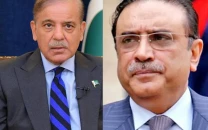SBP keeps benchmark interest rate at 6%
One of the major reasons for the central bank to maintain the benchmark interest rate is a rising trend in inflation

SBP keeps benchmark interest rate at 6%
One of the major reasons for the central bank to maintain the benchmark interest rate is a rising trend in inflation. This is reflective of a pickup in aggregate demand in the wake of an improved security situation and real incomes, it said.
Expectation: SBP will maintain benchmark interest rate, analysts predict
The policy rate is the interest rate that the SBP tries to maintain in the interbank market to control money supply in the economy and achieve price stability and economic growth targets. It reduced the policy rate from 6.5% to 6% last September after bringing it down by 300 basis points in 2014-15. The central bank has maintained it at 6% in the subsequent monetary policy announcements in November, January and April.
After bottoming out in September 2015, the year-on-year Consumer Price Index (CPI) is on a rising trend. Similarly, both core and non-core inflation indicators have shown an upward trend in recent months. “Nevertheless, this rise in inflation was anticipated and the benign inflation outlook for the remaining months of 2015-16 remains largely unchanged,” the SBP said in the statement.
The increase in aggregate demand, the SBP said, is reflected in the acceleration in construction activities, rising demand for consumer goods and expansion in the services sector.
Market watch: Stock market remains volatile, ends in black
Credit to the private sector is on the rise on account of the low borrowing cost, the SBP pointed out, as the benchmark interest rate is hovering at record-low levels. In particular, fixed investments have increased for the fifth quarter. “With positive consumer sentiments and incremental lending rates at considerably lower levels, the uptake of credit by the private sector is expected to end 2015-16 on a higher level than that of 2014-15,” the SBP said.
The central bank highlighted improved business sentiments, lower input prices and better energy availability as the main reasons for the improvement in supply conditions. The excess stock of major food items and the pass-on of lower oil prices to domestic consumers in February are expected to keep downward pressure on inflation, it said.
The SBP also highlighted the recent stability in the rupee-dollar parity, contained budget deficit, increased tax collection and surplus in balance of payment as major positive developments. However, it showed concerns about the decline in exports and called it “worrisome”.
“General weakness in global trade further accentuates this risk. Hence, the current improved domestic environment provides for the necessary conditions to inculcate better value addition and diversify products and markets for sustainable growth of exports,” the SBP said while explaining its decision against further lowering the benchmark interest rate.



















COMMENTS
Comments are moderated and generally will be posted if they are on-topic and not abusive.
For more information, please see our Comments FAQ